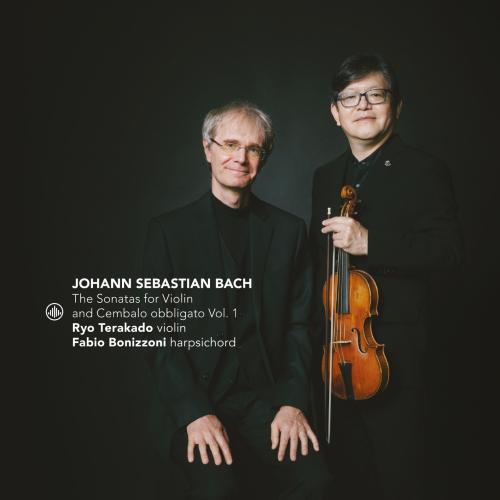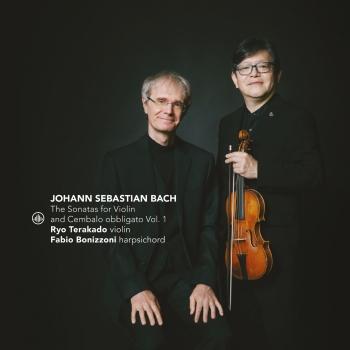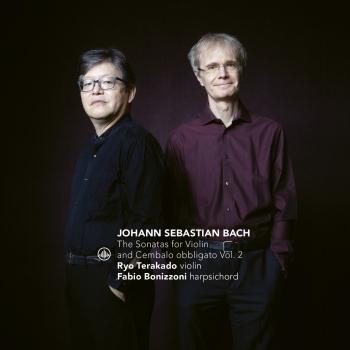
Johann Sebastian Bach: The Sonatas for Violin and Cembalo Obbligato Vol. 1 Fabio Bonizzoni & Ryo Terakado
Album info
Album-Release:
2021
HRA-Release:
14.01.2022
Label: Challenge Classics
Genre: Classical
Subgenre: Chamber Music
Artist: Fabio Bonizzoni & Ryo Terakado
Composer: Johann Sebastian Bach (1685-1750)
Album including Album cover Booklet (PDF)
- Johann Sebastian Bach (1685 - 1750): Sonata No. 1 in B Minor, BWV 1014:
- 1 Bach: Sonata No. 1 in B Minor, BWV 1014: I. Adagio 03:12
- 2 Bach: Sonata No. 1 in B Minor, BWV 1014: II. Allegro 02:58
- 3 Bach: Sonata No. 1 in B Minor, BWV 1014: III. Andante 03:07
- 4 Bach: Sonata No. 1 in B Minor, BWV 1014: IV. Allegro II 03:36
- Sonata No. 2 in A Major, BWV 1015:
- 5 Bach: Sonata No. 2 in A Major, BWV 1015: I. [Dolce] 02:51
- 6 Bach: Sonata No. 2 in A Major, BWV 1015: II. Allegro Assai 03:13
- 7 Bach: Sonata No. 2 in A Major, BWV 1015: III. Andante un poco 02:54
- 8 Bach: Sonata No. 2 in A Major, BWV 1015: IV. Presto 04:34
- Sonata No. 3 in E Major, BWV 1016:
- 9 Bach: Sonata No. 3 in E Major, BWV 1016: I. Adagio 03:41
- 10 Bach: Sonata No. 3 in E Major, BWV 1016: II. Allegro 03:14
- 11 Bach: Sonata No. 3 in E Major, BWV 1016: III. Adagio ma non tanto 04:32
- 12 Bach: Sonata No. 3 in E Major, BWV 1016: IV. Allegro II 04:02
Info for Johann Sebastian Bach: The Sonatas for Violin and Cembalo Obbligato Vol. 1
Johann Sebastian Bach entwickelte einen neuen Stil, das Cembalo obbligato, bei dem die rechte Hand des Tasteninstruments als Melodieinstrument spielt und die gleiche Bedeutung wie die Violine, die Flöte oder ein anderes Soloinstrument erhält. Zu seinen Sonaten für Melodie- und Tasteninstrumente gehören Werke für Flöte, Violine und Viola da Gamba. Es scheint, dass ihn der obligate Stil mehr interessierte als die traditionelle Continuo-Rolle für das Tasteninstrument. Für die Violine gibt es zwei Sonaten mit Basso continuo und sechs mit Cembalo-Obligato. Von diesen Werken sind vor allem die sechs Sonaten als ein Satz konzipiert, mit einem einheitlichen Stil und einer wohlüberlegten Tonartenverteilung. Dieser Satz ist einer der Höhepunkte im Katalog der Bachschen Kammermusik. Bachs Sohn Carl Philippe Emmanuel Bach schreibt 1774 an Bachs ersten Biographen, Johann Nikolaus Forkel: "Die 6 Clavier- [und Violin-] Trios ... gehören zu den besten Werken meines geliebten Vaters. Noch jetzt klingen sie sehr gut und bereiten mir viel Freude, ungeachtet der Tatsache, dass sie über fünfzig Jahre alt sind." Die Tonartenverteilung ist einigermaßen symmetrisch, was darauf hindeutet, dass Bach sie als eine Reihe von Stücken für Violine gedacht hat, vergleichbar mit seinen unbegleiteten Sonaten und Partiten für Violine. Mit Ausnahme der Sonate Nr. 6 folgen alle diese Werke dem Stil der Kirchensonate.
Ryo Terakado, Violine
Fabio Bonizzoni, Cembalo
Ryo Terakado
The Bolivian-born Japanese violinist and conductor, Ryo Terakado, started to play violin at the age of 4. He won the 2nd prize in the All Japan Youth Musical Competition when he was 14 years old. He studied violin, chamber music and conducting at the Toho Gakuen School of Music. In 1983, he won the 3rd prize in the All Japan Music Competition. At the time when graduating at the Toho Gakuen, he was invited as a concertmaster of The Tokyo Philharmonic Orchestra, where he served for 2 years.
Ryo Terakado’s interest in Baroque music already started before: When he was 19, he started to play Baroque violin by himself. Some years later, he founded a Baroque ensemble Concert Spirituel together with Masahiro Arita (flute) and Hidemi Suzuki (cello). In 1985, he came to the Netherlands to study the Baroque violin at the Royal Conservatoire in The Hague under guidance of Sigiswald Kuijken.
Since 1987, Ryo Terakado played with many Baroque orchestras in Europe and Japan as a concertmaster: Les Arts Florissants, La Chapelle Royale, Collegium Vocale Gent, Tokyo Bach Mozart Orchestra etc. Presently he is the concertmaster of La Petite Bande and Bach Collegium Japan. He plays regularly concertos by i.e. J.S. Bach, Antonio Vivaldi, W.A. Mozart with the above-mentioned orchestras.
Fabio Bonizzoni
one of the leading Italian harpsichordists and organists of his generation, graduated in organ, organ composition and harpsichord at the Royal Conservatorium in The Hague in Ton Koopman’s class.
After having played for several years with some of the most important orchestras specializing in early music (Amsterdam Baroque, Le Concert des Nations, Europa Galante), from 2004 he exclusively devotes himself to his activities as soloist and director, in particular of his own orchestra “La Risonanza”.
Furthermore, he is harpsichord professor at the Royal Conservatory of The Hague (Holland) and in Italy at the Conservatory of Novara; he is founder and president of the “Associazione Hendel”, a society devoted to the studies of Handel’s music in Italy.
As a soloist he has been recording for many years for the Spanish label Glossa. His discography includes works by Claudio Merulo, Giovanni Salvatore, Giovanni Picchi, Francesco Geminiani, Bernardo Storace, Domenico Scarlatti and Johann Sebastian Bach (Goldberg Variations and the Art of Fugue). His last release as a soloist is devoted to the two books of toccatas by Girolamo Frescobaldi.
In 2010 he has completed with La Risonanza the project of recording the complete Italian Cantatas with instruments by G.F. Handel: this project has been defined by Gramophone magazine the most important of the decade, and 3 of the 7 CDs have been awarded the prestigious Handel Stanley Sadie Prize. The last disc issued, « Apollo e Dafne », is winner of a Gramphone Award in 2011.
His activity is also enriched by some commitments as guest conductor; in particular in April 2011 he conducted the orchestra of Teatro alla Scala in Milano in the new ballet “L’altro Casanova”.
Booklet for Johann Sebastian Bach: The Sonatas for Violin and Cembalo Obbligato Vol. 1














